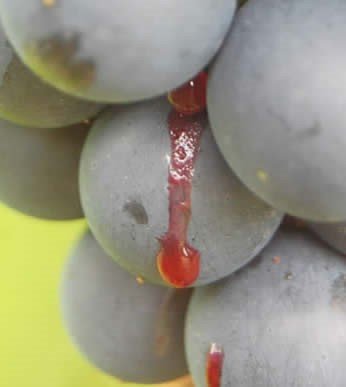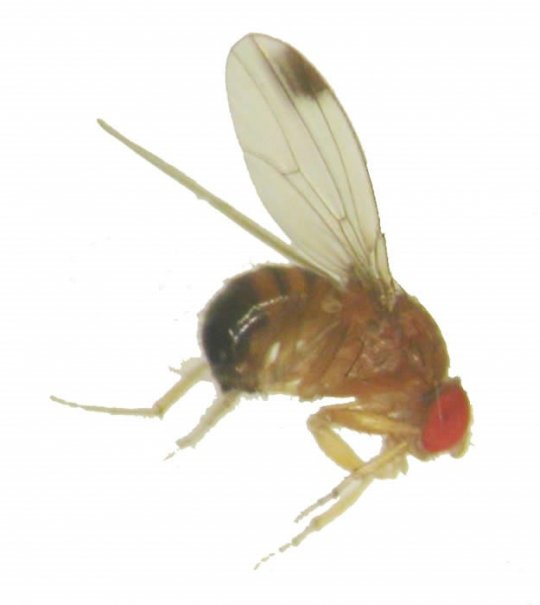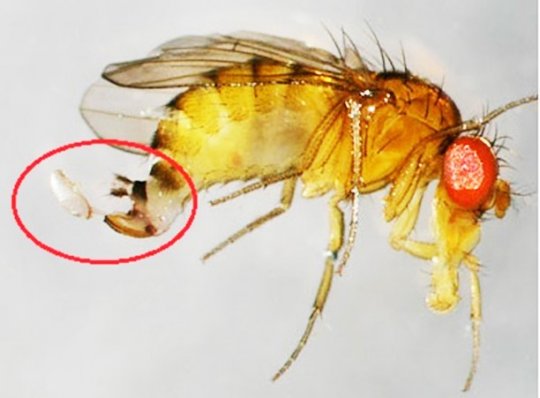Drosophila suzukii is a pest native to Asia that was identified in France in 2010. In September 2014, it was observed for the first time in vineyards in South West France. It causes significant damage to many fruit species, in particular, cherries and small red fruit and is also found on grapes. Drosophila suzukii belongs to the Diptera order in the Drosophilidae family, genus Drosophila.
2.4.3.h Spotted-wing drosophila (Drosophila suzukii)
What damage does drosophila suzukii cause in the vineyard?
Drosophila suzukii has the particularity of being able to infest fruit still on the plant, without damage, prior to harvest. Its clearly visible ovipositor, covered with thick black teeth that cover 1/3 to 2/3 of its length, allows it to lay eggs in under-ripe fruit. Drosophila suzukii uses a saw to pierce the skin of the fruit and insert the egg. As soon as they hatch, the larvae feed on the pulp of the fruit, causing it to collapse and the epidermis to become sunken. At an advanced stage of damage, the fruit's flesh is broken down and oxidized. The wound becomes an entry point for fungi such as botrytis to develop on neighbouring bunches not affected by Drosophila suzukii.
How can drosophila suzukii be recognized?
It is not possible to determine the Drosophila species from observation of the larvae, eggs or pupae. In Diptera, the intermediate stage between larva and imago is called a pupa or a maggot.
Recognizing the adult is the only way to confirm the species of Drosophila present. This has the appearance of a common drosophila that can be seen on acid rot sites.
Adults measure between 2.6 and 3.4 mm with the female generally larger than the male. The male is easily recognized by two black spots on the wings.
These marks begin appearing about ten hours after the emergence and are at their most intense after two days. Female identification requires a binocular magnifying glass to observe the larger size of the ovipositor than other Drosophila species.
These criteria are sufficient to recognize the species in France because, currently, it is the only species in the country with these features.
What is the biology of drosophila suzukii?
Drosophila suzukii has the particularity of having a short life cycle allowing up to 13 generations per year. Studies are still in progress to fully understand its life cycle. Female fertilization takes place before the winter period. They spend the winter in adult form in various protected locations (shelters, forests, etc.).
Several days of intense cold during the winter would seem to be detrimental to their survival. The female uses her ovipositor to perforate the berries epidermis and deposit an egg. The egg incubates from 1 to 3 days before the 3 larval stages follow one another over a period of 3 to 13 days. At the end of the third stage, pupation takes place for 3 to 13 days inside or outside the fruit.
The adult then tears the pupa to emerge. The cycle can be very short, which enables a high dispersal potential. The adults are relatively mobile and can travel several kilometres. The adult life expectancy varies from 3 to 9 weeks, during which time the female may lay an average of 380 eggs.
What are the preventive measures?
Since Drosophila suzukii prefers humid conditions, preventive measures such as leaf removal can be implemented. Studies are underway on the use of garlic as a repellent and the application of kaolinite to the bunches to make them appear less red and therefore less visible to Drosophila suzukii. Studies of varietal susceptibility are also being carried out. No difference has been observed so far for strawberries and cherries. In order to limit the spread of outbreaks, the immediate implementation of simple prophylactic measures consisting of eliminating the affected bunches (manual sorting) and removing them from the plots is recommended. The storage of marc (fermentation residues) near plots is strongly discouraged.
Extract from Vigne Vin Occitanie.
What treatments are available?
Protection is not mandatory for this pest. Insecticides approved for use against flies on vines can be used to treat Drosophila suzukii but there has been no conclusive study on treatment positioning in vineyards in France.
Spinosad is a neurotoxicant resulting from the fermentation of the actinomycete bacterium Saccharopolyspora spinosa. It is approved in organic winegrowing to treat against flies, drosophila, thrips, moths and grapevine moths (Lobesia botrana and Eupoecilia ambiguella).
It is considered non-mutagenic, non-toxic for reproduction, non-carcinogenic and non-neurotoxic. However, it is a bio-insecticide that ranges from toxic to highly toxic for pollinators (bees and bumblebees).
Bacillus thuringiensis (Bt) is a gram-positive bacterium used as a bio-pesticide against grapevine moths and drosophila. It is a bacterium that produces toxins with an insecticidal activity during sporulation. Bt is primarily used to kill insect larvae that ingest the spores of the bacterium and then die due to their insecticidal action.



